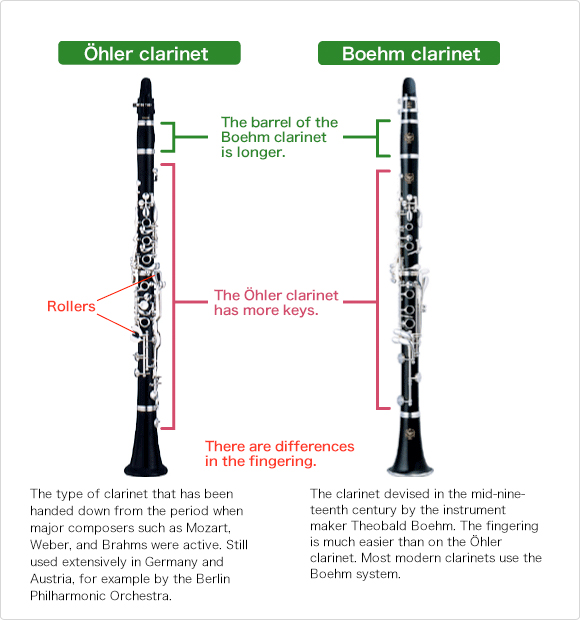
The lever of the B♭ key named above ends close to the back thumb-hole, and answers a double purpose. The latter are obtained by a contrivance which forms the chief initial difficulty in learning the instrument, but has the advantage of giving it a very extended compass. This register is termed Chalumeau, and is of a somewhat different quality from the higher notes.

The lowest note is emitted through the bell the treble G through a hole at the back of the tube, peculiar to this instrument. These are produced by removal of the eight fingers and the thumb of the left hand successively from nine open holes, and by the lifting of nine closed keys. The fundamental scale comprises nineteen semitones, from E in the bass stave. The clarinet consists essentially of a mouth-piece furnished with a single beating reed, a cylindrical tube, terminating in a bell, and eighteen openings in the side, half closed by the fingers, and half by keys. It certainly removes some difficulties, but at the expense of greatly increased complication of mechanism, and liability to get out of order. It may however be remarked here, that Boehm or Klosé's fingering is hardly so well adapted to this as to the octave scaled instruments. A general description of the older and more usual form will be given. The last-named musician (1843) completely reorganised the fingering of the instrument, on the system commonly called after Boehm, which is also applied to the flute, oboe, and bassoon.

Since its first invention it has been successively improved by Stadler of Vienna, Iwan Muller, Klosé, and others. The present name, in both forms, is evidently a diminutive of Clarino, the Italian for trumpet, and Clarion the English equivalent, to which its tone has some similarity. Chappell is however of opinion that he can trace the instrument back to mediæval times as the shawm, schalm, or schalmuse (Hist, of Music, i.

An instrument of 4-foot tone, with a single reed and smooth quality, commonly said to have been invented about the year 1690, by Johann Christopher Denner, at Nuremberg.


 0 kommentar(er)
0 kommentar(er)
